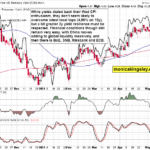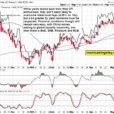
Tobin’s Q, a market-valuation metric, is back in the news, in part thanks to a widely read Bloomberg article. The story, published earlier this week, offered the provocative title: “Nobel Winner’s Math Is Showing S&P 500 Unhinged From Reality.” Oh, my, that sounds serious. Or maybe not. As several observers have pointed out (see here, here, and here, for instance), the practical connection between real-world money management and Tobin’s Q is a dicey proposition. It does, however, provide the raw material for dramatic headlines.
Bloomberg’s article brings up the issue of valuation metrics generally, which should be used with caution. The problem is two-fold. First, accounting-based measures of stock market valuation aren’t timely–the underlying data arrives with a considerable lag. Corporate earnings for a given quarter, for instance, are published months after the fact. Second, the link between valuation and return is relatively weak for time horizons below three years. That’s not an issue if you’re truly investing with a very long horizon. But that’s a very small minority of investors (despite the claims to the contrary).
That doesn’t mean we should ignore valuation. But in a world with many possibilities for estimating value (or the lack thereof), Tobin’s Q certainly wouldn’t be my first choice (Professor Shiller’s CAPE, for example, is a more practical albeit still-flawed alternative). In any case, “high” and “low” market-valuation definitions come in many flavors. But the idea that any one—even a relatively robust measure–is a silver bullet for making real-time decisions about expected return for the near-term horizon is just asking for trouble.
The bigger lesson is that if you’re modeling the market in an effort to develop some relatively objective measures on the potential for severe corrections (aka bear markets and crashes), it’s wise to look at a diversified set of gauges. Market valuation can and probably should be on the short list, but only with the understanding of its limitations. Its one factor and arguably an important factor, but its application as a timing tool waxes and wanes. Unfortunately, it’s rarely clear when it’s useful, or not, without the benefit of hindsight. Actually, that’s true for every other metric, which is why it’s crucial to think long and hard about building a robust benchmark that draws on an array of signals for monitoring what we might call crash-risk potential. But that’s a subject for another day.
















